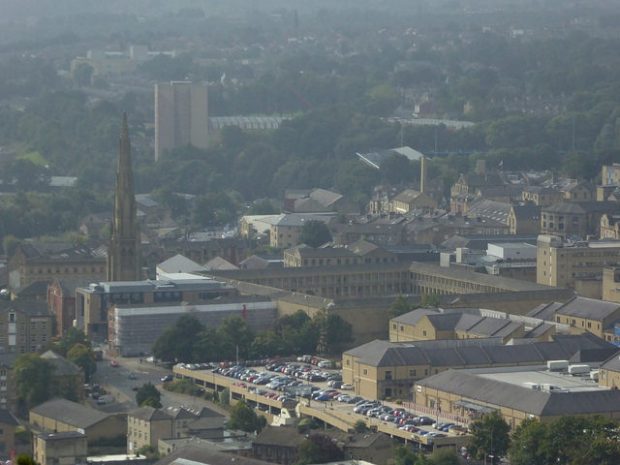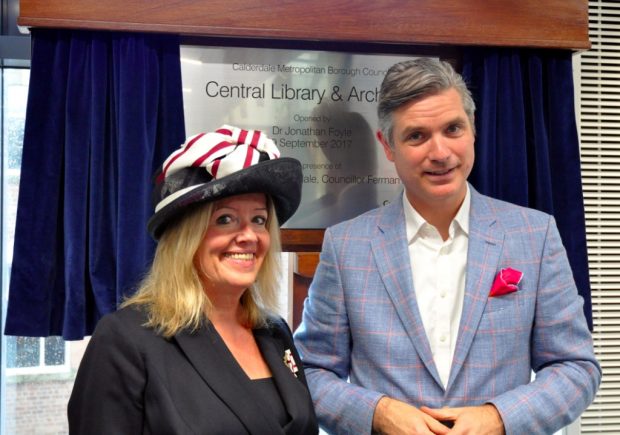[Editor’s note: a post jointly written by the Taskforce team member who attended the opening ceremony, and Jon Medcalf from the Calderdale Libraries team]
The new central library and archives in Halifax is situated next to the new Calderdale Industrial museum (which was also opened on 9 September), and by the newly refurbished Piece Hall. The latter is a Grade I listed building - unique in England as a remnant of the industrial wool weaving past.

Regeneration project
At the opening ceremony, Tim Swift, Leader of Calderdale Council, talked about the decision to build the library in this location. He described how he came across council minutes from 10 years ago when they first looked at what to do with Northgate House (home of the old library) and set out plans for relocation. He said they could have been pragmatic and chosen a simple option, but instead took the brave - and to some controversial - decision to develop a brand new library on this site.
Objectives of the project were to take an overall view at what was possible to regenerate the town. They knew that a 4th entrance into the refurbished Piece Hall (previously a secure space with only one gate), to better link the town with the station, was needed. The library is a key part of their urban renaissance model. Having a group of buildings like this, they hope will attract other investors - and he described how Leeds Beckett University are already planning a business school in a nearby part of the new cultural quarter.
New library building
Any project adjoining a Grade I listed building, and incorporating parts of an old one, was going to be a challenge. Every single one of the locally handmade bricks was drawn by hand in the plans, and sample walls were built to make sure the bricks were exactly the right style, shape and colour to blend with the Piece Hall and the town’s many historical buildings. These bricks - still made according to centuries-old techniques - are visible internally and externally, and form a smooth transition from the original structures of the former Square church into the new-build elements of the building.

The library also includes the former church’s spire - one of the highest in England when still an active church - which forms an easy landmark across the whole town and neighbouring hills. The spire now boasts new active clock-faces, struck by the same Midlands firm involved in the original work, and even involving one worker who had (as a young apprentice) fitted the original clock.
Inside the library
Besides the usual components of fiction, non fiction and a children’s section, the new building has lots of flexibility to develop. Close to the entrance is a space where the glass screen is etched with the name: The Lab. Currently housing a 3D printer and desks with computers, the library team works with local groups to develop that space for job-seeking and IT support throughout weekdays.
The library is more correctly referred to as Central Library and Archive, as the basement houses one branch of the West Yorkshire Archives services, as well as the local history collection. On opening day, there was a display of lots of old local maps, and people were eagerly poring over them trying to locate places they recognised.
There is plenty of study space, with the top floor having both study carrels and bookable small rooms available, among the non-fiction and reference collection. Other spaces include a media store which, when the normal contents of the room are moved around, easily makes the space into a performance space - a bijou cinema for public events. A nearby strikingly-designed book lined ‘pod’ is aimed at attracting teenagers - and any other readers - to linger.

Overall, there are lots of comfy chairs scattered throughout - an invitation to stay. Also toilets and stable wifi, with no login required. I was also quite intrigued by the touch screens on the end of some shelf units - access to the catalogue, websites and social media, and the PC booking system.
Watch a behind the scenes video of preparations for the move - includes architects designs and comments from the team.
Opening ceremony
Robin Tuddenham, Chief Executive of Calderdale Council, welcomed people to the next phase in the development of ‘our vibrant cultural quarter’ and commented that, after the doors had opened to the public on Tuesday 5 September, there had been 8,000 visitors and 1,500 items loaned by Thursday. [Update: Since the opening, loans and new borrowers have averaged 150% on the equivalent period in 2016].
He also introduced the creative project which ran alongside the building of the library: ‘We all have a story to tell’. The video shows how a wide number of creatives: textile artists, creative writers, musicians and film makers, were inspired by 4 ‘Living Books’ - 4 characters who had shaped Halifax (including Percy Shaw, inventor of the road safety cats eye) - to create material.
The team have produced a video of the opening ceremony which was extremely well attended, both by invited guests and library visitors. Besides Robin Tuddenham and Tim Swift, the Mayor of Calderdale, Councillor Ferman Ali, also spoke.
Virginia Lloyd, Deputy Lieutenant of West Yorkshire, gave a powerful endorsement. Describing herself as “a Halifax girl and bookworm who spent hours in the local library”, she described it as “a place of refuge, with a tranquil and supportive atmosphere”. The building is doubly appropriate for her, as her husband is a historian who has also spent hours in archives. She praised both the project and the whole area of regeneration in Halifax.

The final speaker was Dr Jonathan Foyle, architectural historian and broadcaster. An enthusiastic supporter of libraries, he said how appropriate the project was as Halifax is all about industry, talent and foresight: “investing in a library is a leap of faith in curiosity”. He shared his story: his walk to comprehensive school was past a library, which was where he found books on all the subjects not taught in school, forming the foundations of his career: architecture and history.
He described how libraries have a proud history in this country: from the 1850 act which allowed boroughs to set up libraries, through the turn of the 19th century when great philanthropists such as Carnegie supported building of many of them, to how libraries adapt to 21st century life. Today, they are not just books, but include sound collections, business advice and exhibitions. He commented that rapid developments in the tech world have also shifted their focus.
He also mentioned his local library, describing Market Deeping library as a real community resource - now run by volunteers. His final comment - before drawing the curtain to reveal the commemorative plaque (now proudly displayed in the library foyer) - was that this new library is at the other end of the scale: an investment. The cultural heritage and learning quarter is a “masterpiece of an idea” - an excellent piece of planning and foresight, and “a temple of serendipity - a tribute to the values that the town was built on”.
And finally
There is more information about the heritage of the Piece Hall on its website, including: “From its inception, The Piece Hall was a stunning combination of commerce and culture, an icon of hard business but also a broader statement about the history, the lives and the values of its surrounding community. This fascinating mix of purpose and idealism – business, arts and people, continues to influence and drive The Piece Hall’s role today. A direct link back over almost a quarter of a millennium of history”. You could say the same about the library...
--------------------------------------------
Please note, this is (partly) a guest blog. Views expressed here do not necessarily represent the views of DCMS or the Libraries Taskforce
4 comments
Comment by Glyn Sutcliffe M.Phil (Chartered Librarian) posted on
In the new Calderdale Library and Archives the traditional reference library stock has been interfiled with non-fiction books. General reference books are at the maximum distance in the building from the local history department. This does not serve the needs of researchers well. The reserve book stock is now 1.5 miles distant from the new facility at the Heath Centre, as is the Schools Service. Bibliographic Services are now located at King Cross Branch Library some 2 miles distance away. Formerly, all services were together on the centralised site of the former library at Northgate. The decentralisation is plainly a retrograde development resulting from political necessity taking precedence over good library management. Critics pointed out from the outset that the new site at Square Road was too small to accommodate all services and this has proved to be the case. Pedestrian access is far more inconvenient compared with the former Centre Library. The library is not state of the art. The former Library was only 30 years old with flexible open plan floors. It should have been refurbished to provide a better facility and in a better location than the new development.
Comment by Glyn Sutcliffe posted on
When the Piece Hall opened in 1779 the industrial revolution was already beginning to change the way in which cloth was manufactured and traded. The factory system was rapidly replacing the domestic system of cloth manufacture. Within less than a generation the Piece Hall was almost obsolete in its role as a trading and distribution centre. In modern parlance it was rendered ‘unfit for purpose’. Ever since that time the authorities of Halifax have understandably struggled to find a suitable new purpose for the Piece Hall. The eighteenth century enlightenment and nineteenth century romanticism, had very different appreciations of the word ‘culture’ than does our own age. The fine Georgian architecture of the Piece Hall had no wider or direct local connection with the performing arts, music or literature. It is wrong to suggest it was a ‘cultural icon’ in terms of artistic culture, or in the more comprehensive sociological sense other than commerce. Such notions are a concoction of modern sales publicity and the tourist orientated ‘culture’ of modern times. This motivation and the expediencies of commercial tourism are exclusive to the modern age and unknown in previous ages. The new granite flagged courtyard and the water features of the refurbished Piece Hall have no significant connection with the iconography of the past. For good or ill they are a modern overlaid statement exclusive to modernity. There is a wide and disjointed disparity between the sociological culture surrounding the Piece Hall when it was built, and how it can be analysed today. It is, therefore, fallacious to state as the Piece Hall website does, in its sales jargon, that:
‘This fascinating mix of purpose and idealism – business, arts and people, continues to influence and drive The Piece Hall’s role today.’
Unfortunately, the Public Library has been dragooned into an inappropriate compromise on an inadequate and restrictive site. It has been conjoined anachronistically with a church spire in an incongruous and wholly impractical manner for future maintenance purposes, or to further modern library services in any constructive way.
Comment by Glyn Sutcliffe posted on
For some undisclosed reason the West Yorkshire Archives for Calderdale has not yet relocated its collections to the new premises. They were due to move in March, but no future date has been announced.
Comment by Glyn S Sutcliffe posted on
As of July 2018 the transfer of the Archive collection from Northgate to Square Road has been completed. The former Calderdale Central Library, at Northgate, constructed in 1983, which for so long was condemned by the Council Cabinet as 'a tired old building' which was 'unfit for purpose', is now to be refurbished as a sixth form college. The public were told that there was no possibility of refurbishment as a library and that the building had to make way for extensive retail development.